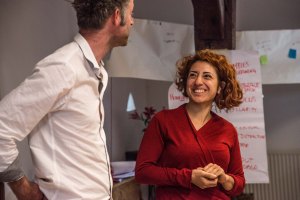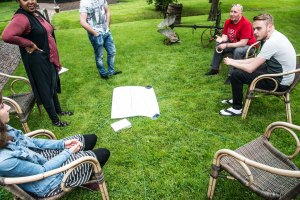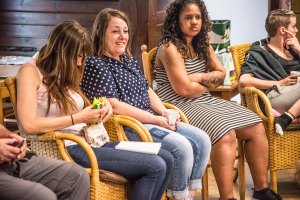Youth participation

In the morning Cilia introduced the ladder of youth participation. In the ladder there are ten levels which all have different meanings. The levels are…
- Dictatorship – Young people are given no choices and participation is forced. Decisions are made by adults for and on behalf of the young people. The assumption is that adults know best and there are no opportunities or structures for young people’s views to be heard.
- Manipulation – Young people are not given opportunities to understand the issues being addressed are not actively involved in decision-making and merely go along with what adults require of them without being given a chance to contribute.
- Decoration – Adults involve young people in promoting a cause which the young people have little understanding of and have had little or no say in deciding about. The young people wear the T-shirt with slogans, perform at an event to bolster the cause and often engage in fun, ‘feel good’ factor activities. Young people are used to bolster a cause which adults think is important.
- Tokenism – Adults organise situations where young people seem to be given a voice but in fact have little choice about the subject and limited opportunities to develop their own opinions or make decisions. Adults set the agenda and young people are expected to fall in line.
- Assigned or informed – Adults set up the framework and processes for a project and young people volunteer to participate when they have understood the intentions of the projects know who makes the decisions and appreciate the nature of the fixed roles.
- Consulted and informed – A project is designed and run by adults but young people understand the processes and their opinions are sought and treated seriously. Young people are not expected to reflect adult ideas and opinions but they are encouraged to develop their own ideas and understandings are helped to make informed judgements.
- Adult-initiated, shared decisions with young people – Both adults and young people are involved in developing ideas, planning projects and decision-making. The experience and knowledge of young people is valued and ways are developed for adults and young people to communicate and make joint decisions. Adults are willing to hand over some control to young people and provide a secure framework, support and direction.
- Young person initiated and directed – Young people take the lead in organising and directing collaborative working groups, supported by adults. Young people develop the confidence and skills to take control and responsibility.
- Young person initiated, shared decisions with adults – Young people take a lead role in developing ideas and proposals, identifying opportunities and problems and formulating strategies for action, the process being supported by adults.
- Young person initiated, no adult support – Young people initiate, manage, take the lead and evaluate their own learning and actions. Young people identify their own opportunities and directions this is usually done for the benefit of the group and other young people. Adults are not involved in any part of the process.
After having the ladder introduced to them the participants split into their mentor groups and were asked to think about two examples of their own work with young people. The groups came back together and shared their examples and the other groups placed it where they thought it sat on the ladder. They had a brief discussion about why they the activity had been placed on that ladder.
The discussion concluded with a discussion about what kind of young people you would work with at the bottom of the ladder, and the aspiration to constantly be moving people up towards to the top.

Seek to understand first then to be understood
During the next session the participants started to introduce Covey’s sixth habit 5 ‘seek to understand first then to be understood’. Cilia started the session by introducing four listening styles to the group. These are attentive, pretending, ignoring and selective. These are all styles which are imperfect as people might be distracted, not listening or only hearing what they want to hear. In mentor groups the participants were asked to prepare a roleplay of how to change from the four typical listening styles to an empathic style where you seek to understand the other person, make helpful suggestions and show an interest.

Each group showed their roleplay for the other participants and there was a discussion about what had been observed. One factor which came out of the discussion was about mobile phones and how they can impact on the ways people listen. The participants felt that while mobile phones are not completely unhelpful in a group dynamic (eg: taking notes, looking up unfamiliar words etc), they can distract the person listening or the speaker so their use in sessions should be considered carefully.
The final exercise was to see ourselves as others see us. The participants were asked to think about an unresolved situation in their lives. They were asked to think about the situation from three positions; themselves, the other person involved and an impartial adviser. The participants split into pairs with each person taking one of two roles…
- The explorer – sharing a situation from their life and being open to thinking about things from other points of view.
- The guide – asking questions about the situation to prompt their partner (the explorer) to see the situation from other points of view. They should go through the three positions (yourself, other person and impartial adviser).
The exercise was designed to get the person to think about how they would change a situation to create a win-win for those involved.

Revisiting Leary for influence
After lunch the group revisited the Rose of Leary, reminding themselves of the behaviours that it includes that they discussed in the second week.
Splitting into their mentor groups the participants were asked to think about how they can use Leary’s theory to influence people showing certain behaviours in a youth work context. They were first asked to consider a situation in an open youth club where young people were arguing about what kind of music should be playing. Half of the small groups took on the role of the youth workers and the other half the young people.

As they showed different kinds of behaviour in the situation they were asked to move around the rose, stepping into different triangles to show what kind of behaviour they were using. After the first situation they were asked to suggest their own to act out.
Finally the group came back together to discuss how they had found the exercise and what they had learnt about how different behaviours can be used to influence young people.


